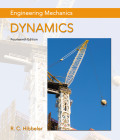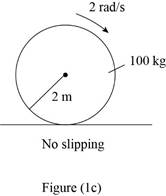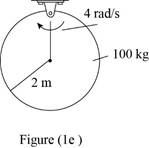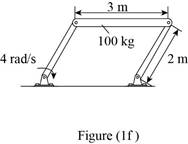
Concept explainers
Determine the kinetic energy of the 100-kg object.

a)
The kinetic energy of the object:
Answer to Problem 1PP
The kinetic energy of the disk is
Explanation of Solution
Given:
The mass of disk is
The angular velocity of the disk is
The radius of the disk is
Draw the free body diagram of the rod as shown in Figure (1a).

Refer Figure (1a).
Write the formula for mass moment of inertia
Here,
Write the formula for kinetic energy
(Rotation about fixed axis).
Substitute
Here,
Conclusion:
Calculate the kinetic energy of the disk.
Substitute
Thus, the kinetic energy of the disk is
b)
The kinetic energy of the object:
Answer to Problem 1PP
The kinetic energy of the disk is
Explanation of Solution
Given:
The mass of rod is
The angular velocity of the rod is
The length of the rod is
Draw the free body diagram of the rod as shown in Figure (1b).

Refer Figure (1b).
Write the formula for mass moment of inertia
Here,
Substitute
Here,
Write the formula for kinetic energy
Substitute
Here,
Conclusion:
Refer Figure (1b).
Calculate the kinetic energy of the rod.
Substitute
Thus, the kinetic energy of the rod is
c)
The kinetic energy of the object:
Answer to Problem 1PP
The kinetic energy of the disk is
Explanation of Solution
Given:
The mass of disk is
The angular velocity of the disk is
The radius of the disk is
Draw the free body diagram of the disk as shown in Figure (1c).

Refer Figure (1c).
Write the formula for mass moment of inertia
Here,
Write the formula for kinetic energy
Here,
Substitute
Here,
Conclusion:
Refer Figure (1c).
Calculate the kinetic energy of the disk.
Substitute
Thus, the kinetic energy of the disk is
d)
The kinetic energy of the object:
Answer to Problem 1PP
The kinetic energy of the rod is
Explanation of Solution
Given:
The mass of rod is
The angular velocity of the rod is
The length of the rod is
Draw the free body diagram of the rod as shown in Figure (1d).

Refer Figure (1d).
Write the formula for mass moment of inertia
Here,
Write the formula for kinetic energy
(Rotation about fixed axis).
Substitute
Here,
Conclusion:
Refer Figure (1d).
Calculate the kinetic energy of the rod.
Substitute
Thus, the kinetic energy of the rod is
e)
The kinetic energy of the object:
Answer to Problem 1PP
The kinetic energy of the disk is
Explanation of Solution
Given:
The mass of disk is
The angular velocity of the disk is
The radius of the disk is
Draw the free body diagram of the disk as shown in Figure (1e).

Refer Figure (1e).
Write the formula for mass moment of inertia
Here,
Write the formula for kinetic energy
Here,
Substitute
Here,
Conclusion:
Refer Figure (1e).
Calculate the kinetic energy of the disk.
Substitute
Thus, the kinetic energy of the disk is
f)
The kinetic energy of the object:
Answer to Problem 1PP
The kinetic energy of the disk is
Explanation of Solution
Given:
The mass of rod is
The angular velocity is
Draw the free body diagram of the object as shown in Figure (1f).

Refer Figure (1f).
Here, the ends of the rod are connected to two rods of same length. Hence the rod travels in circular motion.
Consider as the mass travels in a radius of
Write the formula for kinetic energy
(Rotation about fixed axis).
Here,
Substitute
Here,
Conclusion:
Refer Figure (1f).
Here
Calculate the kinetic energy of the disk.
Substitute
Thus, the kinetic energy of the disk is
Want to see more full solutions like this?
Chapter 18 Solutions
Engineering Mechanics: Dynamics (14th Edition)
- If the 10-g bullet is traveling at 310 m/s when it becomes embedded in the 11-kg block, determine the distance the block will slide up along the plane before momentarily stopping.arrow_forwardJust like the change in momentum over time generates a force (P=F) , the change in ∆t angular moment results in a torque (L = τ) . Using the theoretical values for the moments∆tof inertia of the hollow cylinder and disk, determine the torque done on the system whenthe cylinder is dropped on the disk. Take ωi = 9.5 rd/s, ωf = 6.1 rd/s, and ∆ t = 2 sarrow_forwardThe 10 Mg truck hauls the 20 Mg trailer. If the truck-trailerstart from rest with constant acceleration achieves a velocity of20 km/h when it travels a distance of 200 m. Determine (a) thetension in the horizontal drawbar, (b) the tractive force betweenthe driving wheels of the truck and the road.arrow_forward
- Determine the distance R where it strikes the ground at Barrow_forwardThe 50-lb crate is subjected to the force F = 40 lb. The coefficient of kinetic friction between the crate and the ground is µk = 0.2. If the crate is initially moving to the right with a velocity of 3 ft/s, determine A) The speed of the block when t = 8 s. B) The power developed by force F at t = 8 s.arrow_forwardThe 10-lb collar starts from rest at A and is lifted by applying a constant vertical force of F = 25 lb to the cord. Part A: If the rod is smooth, determine the power developed by the force at the instant θ = 60 degressarrow_forward
- A roller coaster car has a mass of 600 kg when fully loaded with passengers. If the car has a speed of 20 m/sec at point A, what is the maximum speed the car can have at B and still remain on the track?arrow_forward14-59 The material hoist and the load have a total mass of 800 kg and the counterweight C has a mass of 150 kg. At a given instant, the hoist has an upward velocity of 2 m/s and an acceleration of 1.5 m/s2. Determine the power generated by the motor M at this instant if it operated with an efficiency of 0.8arrow_forwardA railroad car having a mass of 15 Mg is coasting at 1.5 m/s on a horizontal track. At the same time another car having a mass of 12Mg is coasting at 0.75 m/s in the opposite direction. If the cars meet and couple together, determine the speed of both cars just after the coupling. Find the difference between the total kinetic energy before and after coupling has occurred, and explain qualitatively what happened to this energyarrow_forward
- The 6-kg spiked pendulum is released in position 1. When the pendulumreaches position 2, the spike “spears” the 2-kg parcel and carries it to position 3 before stopping momentarily. Determine the angle θ in position 3.arrow_forwardEach of the two elastic rubber bands of the slingshot has an unstretched length of 200 mm. If they are pulled back to the position shown and released from rest, determine the maximum height the 25-g pellet will reach if it is fired vertically upward. Neglect the mass of the rubber bands and the change in elevation of the pellet while it is constrained by the rubber bands. Each rubber band has a stiffness k = 50 N/m.arrow_forwardThe winding drum D is drawing in the cable at an accelerated rate of 4.5 m/s^2. Determine the cable tension if the suspended crate has a mass of 1000 kg.arrow_forward
 Elements Of ElectromagneticsMechanical EngineeringISBN:9780190698614Author:Sadiku, Matthew N. O.Publisher:Oxford University Press
Elements Of ElectromagneticsMechanical EngineeringISBN:9780190698614Author:Sadiku, Matthew N. O.Publisher:Oxford University Press Mechanics of Materials (10th Edition)Mechanical EngineeringISBN:9780134319650Author:Russell C. HibbelerPublisher:PEARSON
Mechanics of Materials (10th Edition)Mechanical EngineeringISBN:9780134319650Author:Russell C. HibbelerPublisher:PEARSON Thermodynamics: An Engineering ApproachMechanical EngineeringISBN:9781259822674Author:Yunus A. Cengel Dr., Michael A. BolesPublisher:McGraw-Hill Education
Thermodynamics: An Engineering ApproachMechanical EngineeringISBN:9781259822674Author:Yunus A. Cengel Dr., Michael A. BolesPublisher:McGraw-Hill Education Control Systems EngineeringMechanical EngineeringISBN:9781118170519Author:Norman S. NisePublisher:WILEY
Control Systems EngineeringMechanical EngineeringISBN:9781118170519Author:Norman S. NisePublisher:WILEY Mechanics of Materials (MindTap Course List)Mechanical EngineeringISBN:9781337093347Author:Barry J. Goodno, James M. GerePublisher:Cengage Learning
Mechanics of Materials (MindTap Course List)Mechanical EngineeringISBN:9781337093347Author:Barry J. Goodno, James M. GerePublisher:Cengage Learning Engineering Mechanics: StaticsMechanical EngineeringISBN:9781118807330Author:James L. Meriam, L. G. Kraige, J. N. BoltonPublisher:WILEY
Engineering Mechanics: StaticsMechanical EngineeringISBN:9781118807330Author:James L. Meriam, L. G. Kraige, J. N. BoltonPublisher:WILEY





